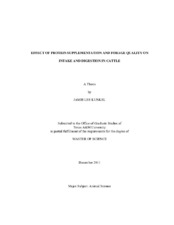| dc.description.abstract | In many pasture and rangeland scenarios, low-quality forages (< 6-8% CP) are the primary energy source for some portion of the year. At these times, energy is typically the first limiting nutrient to the ruminant. Low-quality forages are generally not limited in availability; however, the high cell wall content and reduced levels of CP prevent ruminants from being able to extract the harvested energy. Without provision of supplemental nutrients, the available energy may be inadequate to meet performance expectations. Protein supplementation during periods of inadequate forage quality has been observed to alleviate ruminal nitrogen deficiencies and increase forage utilization. Increased forage utilization translates into greater energy extraction allowing for increased animal performance.
The first trial was conducted to evaluate the effects of utilizing non-protein nitrogen (a slow-release urea compared to urea) on intake and digestion of beef steers consuming low-quality bermudagrass hay. Steers were provided ad libitum access to a low-quality bermudagrass hay (7.3 % CP and were ruminally dosed once daily with either urea or slow-release urea (SRU) at levels to provide 0, 64, 128, or 192 mg of N/kg of initial BW per day. Additionally, steers were supplemented with glycerol at levels of 0 or 0.1% of initial BW per day. Total OMI and forage OMI (FOMI) increased quadratically (P < 0.01) with NPN supplementation. However there was not a difference in total OMI or FOMI between urea and the SRU (P = 0.24 and 0.21, respectively). The largest increases in FOMI and total OMI occurred with the first level of supplementation (64 mg N/kg BW) for both urea and SRU and intake peaked when 128 mg N/kg BW was supplemented. Total OMD was not affected by N supplementation level however N from urea tended to elicit a greater response than from the SRU (P = 0.01). Ruminal OMD increased linearly (P = 0.07) and ruminal NDF digestion increased quadratically (P = 0.09) with N supplementation.
The second experiment was conducted to evaluate the effects of hay crude protein and protein supplementation on intake and digestion in beef steers. Steers received one of three bermudagrass (Cynodon Dactylon) hays of differing nutritive value (7.0, 8.4, or 13.4% CP) and either 0 or 156 mg N/kg BW supplemented as cottonseed meal once daily. No significant Hay x CSM interactions were observed for hay OMI, total OMI, TDOMI, or digestible NDF intake (P >= 0.67). Hay OMI and total OMI increased linearly (P < 0.01) with hay nutritive value. A quadratic response (P = 0.03) was observed for TDOMI with increasing hay nutritive value. This response was largely driven by a quadratic increase (P < 0.01) in OM digestion with increasing nutritive value of hays. Supplementing CSM generally did not affect HOMI (P = 0.63) although TDOMI (P = 0.03) was increased. Similarly, OM digestion (P = 0.61) and NDF digestion (P = 0.11) were not impacted by CSM supplementation. | en |


